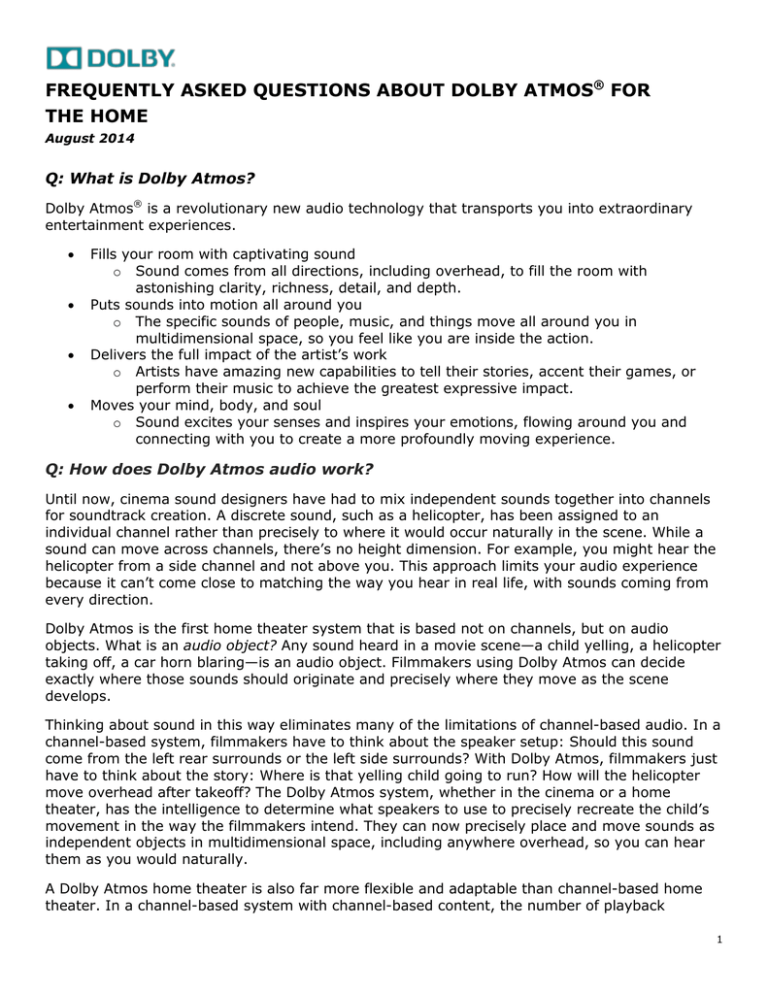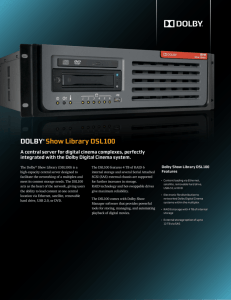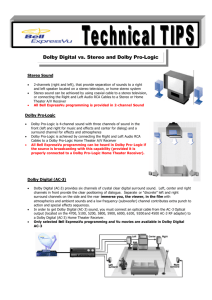
FREQUENTLY ASKED QUESTIONS ABOUT DOLBY ATMOS® FOR
THE HOME
August 2014
Q: What is Dolby Atmos?
Dolby Atmos® is a revolutionary new audio technology that transports you into extraordinary
entertainment experiences.
Fills your room with captivating sound
o Sound comes from all directions, including overhead, to fill the room with
astonishing clarity, richness, detail, and depth.
Puts sounds into motion all around you
o The specific sounds of people, music, and things move all around you in
multidimensional space, so you feel like you are inside the action.
Delivers the full impact of the artist’s work
o Artists have amazing new capabilities to tell their stories, accent their games, or
perform their music to achieve the greatest expressive impact.
Moves your mind, body, and soul
o Sound excites your senses and inspires your emotions, flowing around you and
connecting with you to create a more profoundly moving experience.
Q: How does Dolby Atmos audio work?
Until now, cinema sound designers have had to mix independent sounds together into channels
for soundtrack creation. A discrete sound, such as a helicopter, has been assigned to an
individual channel rather than precisely to where it would occur naturally in the scene. While a
sound can move across channels, there’s no height dimension. For example, you might hear the
helicopter from a side channel and not above you. This approach limits your audio experience
because it can’t come close to matching the way you hear in real life, with sounds coming from
every direction.
Dolby Atmos is the first home theater system that is based not on channels, but on audio
objects. What is an audio object? Any sound heard in a movie scene—a child yelling, a helicopter
taking off, a car horn blaring—is an audio object. Filmmakers using Dolby Atmos can decide
exactly where those sounds should originate and precisely where they move as the scene
develops.
Thinking about sound in this way eliminates many of the limitations of channel-based audio. In a
channel-based system, filmmakers have to think about the speaker setup: Should this sound
come from the left rear surrounds or the left side surrounds? With Dolby Atmos, filmmakers just
have to think about the story: Where is that yelling child going to run? How will the helicopter
move overhead after takeoff? The Dolby Atmos system, whether in the cinema or a home
theater, has the intelligence to determine what speakers to use to precisely recreate the child’s
movement in the way the filmmakers intend. They can now precisely place and move sounds as
independent objects in multidimensional space, including anywhere overhead, so you can hear
them as you would naturally.
A Dolby Atmos home theater is also far more flexible and adaptable than channel-based home
theater. In a channel-based system with channel-based content, the number of playback
1
speakers is fixed: a 7.1 system consisting of seven speakers and one subwoofer is used to play
7.1 content. Additionally, there is no height information in the content. With Dolby Atmos, in
contrast, you have amazing flexibility: the format provides even richer, more detailed sound by
rendering to overhead or height speakers and/or to more than seven speakers at the listener
level. As you add speakers, a Dolby Atmos enabled receiver will use them to create even more
fantastic, immersive audio.
With the revolution in audio that is Dolby Atmos, sound designers are freed from channel
restrictions. Sounds flow above and around you in step with the visuals, bringing a new sense of
height and reality to your listening experience. Dolby Atmos helps weave the audio story to
match what’s happening on the screen. It puts you in the middle of the action—in ways you
have never experienced before.
Q: What is the difference between Dolby Atmos in the cinema and Dolby Atmos
in the home?
The cinema, with its giant screen and massive sound system, will always be the reference for
the ultimate entertainment experience. While home theaters have fewer speakers, the Dolby
Atmos home experience is extremely powerful. It combines traditional home theater speaker
layouts with many new possible speaker positions, including either ceiling-mounted speakers or
new Dolby Atmos enabled speakers that reproduce sounds coming from above you. The impact
of either in-ceiling or Dolby Atmos enabled speakers is breathtaking; your room fills with realistic,
multidimensional sound that places you directly in the center of the entertainment experience.
Q: How does Dolby Atmos cinema content transition to home theaters?
The Dolby Atmos experience in the cinema is so powerful and flexible because of its
revolutionary use of audio objects. To deliver the full object-based soundtrack to home theaters,
Dolby developed new home authoring tools and new encoding methods that take into account
the spatial information of the sound objects to efficiently encode them in Dolby® TrueHD and
Dolby Digital Plus™. This spatial coding is not a channel-based, matrix-encoding system like
Dolby Pro Logic® II or Dolby Pro Logic IIz. Instead, this fundamentally new coding technique
allows all the audio objects created for the cinema to be used in the home theater. Nothing is
lost.
Initially, home theaters will be able to play Dolby Atmos content on Blu-ray™ discs or through
streaming video services. No matter the source, when a Dolby Atmos stream is fed to a Dolby
Atmos compatible A/V receiver, the receiver will render the object-based audio to your home
theater’s unique speaker configuration to precisely recreate the sound the filmmakers intended.
Because the object-based audio mix is delivered to home theaters, Dolby Atmos has the ability
to adapt to extremely diverse speaker setups, from systems with five speakers on the floor and
two speakers producing overhead sound to Dolby Atmos supersystems with 24 speakers on the
floor and 10 overhead speakers.
Q: Who is creating content, such as movies, for Dolby Atmos in the home?
Globally, more than 100 cinema blockbusters have been released featuring Dolby Atmos
soundtracks since 2012, and many more are on the way. Major Hollywood studios are partnering
with Dolby to create home video versions of current box office releases—and previously released
favorites—for release in 2014. In addition to global studio partnerships, Dolby is partnering with
game and music content creators to take advantage of Dolby Atmos technology for future home
theater use.
2
Q: What home setup do I need to experience Dolby Atmos?
To experience this sound revolution, you’ll need a way to play or stream Dolby Atmos content,
and to create your own Dolby Atmos home theater environment.
Options to Play or Stream Content
1. You can play Dolby Atmos content from a Blu-ray Disc™ through an existing Blu-ray Disc
player. Be sure you have a player that’s fully compliant with Blu-ray specifications.*
Or
2. You can stream content from a compatible game console, Blu-ray, or streaming media player.
In both cases, be sure to set your player to bitstream output.** Note that Dolby Atmos is
compatible with the current HDMI® specification (v1.4 and later).
You then have several options for configuring your home playback system.
You’ll be able to assemble your own system from a wide range of available A/V components,
starting with an A/V receiver (AVR) or pre-processor that supports Dolby Atmos. Many leading
AVR manufacturers are introducing products in 2014 that support Dolby Atmos for the home.
Several companies will offer complete home-theater-in-a-box solutions that support Dolby
Atmos. These systems offer you the benefits of extraordinary Dolby Atmos sound together with
the convenience and simplicity of an all-in-one system.
Watch for announcements throughout the year.
* You will not need to replace your Blu-ray player as long as it fully conforms to the Blu-ray specification. Currentgeneration Blu-ray players, and most older players, are compatible. You should check with the Blu-ray player
manufacturer if you encounter problems. Some Blu-ray players default to secondary audio, a playback mode where
third party content is mixed with the primary soundtrack and output as a Dolby Digital signal. Be sure to turn this
feature off to insure decoding and playback of Dolby Atmos content by your AVR.
** Decoding and rendering of Dolby Atmos content is managed entirely by the A/V receiver. To properly pass the
Dolby Atmos audio to the AVR, source devices must be connected to the AVR via HDMI and set to audio bitstream out.
Q: I already have a home theater. Do I have to replace all of my current
speakers to build a Dolby Atmos system?
No.
Many people now have 5.1 or 7.1 systems with a subwoofer and either five or seven speakers
positioned at or about at ear level. Many of these speakers will work without a problem in a
Dolby Atmos system.
However, overhead sound is a vital part of the Dolby Atmos experience. Many current home
theaters aren’t capable of producing overhead sound, but there are a number of options for
adding this capability to any room.
Q: How do I get sound coming from above?
The obvious answer is to install speakers in the ceiling. Most conventional ceiling speakers will
work in a Dolby Atmos home theater.
3
But installing ceiling speakers may not be possible or desirable for you. Installing speakers in or
on your ceiling and running the necessary wiring can be expensive and time consuming. If you
rent your home, the property owner may not allow it. And if your ceiling is made of a material
such as concrete, plaster, or brick, installing speakers in the ceiling is impossible. Finally, you
may not like the look of overhead speakers.
Q: How can I get overhead sound if I don’t mount speakers in my ceiling?
Use speakers equipped with Dolby Atmos enabled technology.
Through our knowledge of psychoacoustics and sound physics, we’ve developed speakers that
can create overhead sound even though they’re only a few feet off the floor. These speakers fire
sound upward, where it reflects off the ceiling to produce an incredibly lifelike recreation of
overhead sound—you really have to hear them to believe them.
You will be able buy integrated Dolby Atmos enabled speakers that include both traditional
forward-firing speakers and upward-firing speakers in one speaker cabinet. (Those speakers
have two sets of posts, one for the traditional speaker and one for the upward-firing Dolby
Atmos enabled speaker.)
But if you already have conventional speakers you like, you can simply buy Dolby Atmos enabled
add-on speaker modules. These include only the upward-firing speakers. You can put the add-on
modules on top of your current speakers or on another nearby surface.
Q: Will Dolby Atmos enabled speakers work in my room?
Dolby Atmos enabled speakers can produce an incredibly accurate Dolby Atmos experience in
many kinds of rooms. You’ll get the best sound if your ceiling is flat (not vaulted or angled) and
made of an acoustically reflective material, such as drywall, plaster, concrete, or wood.
While we designed the technology for rooms with ceiling heights of 8 to 9 feet (2.4 to 2.7
meters), our testing indicates that you can still hear incredible Dolby Atmos sound in rooms with
ceilings as high as 14 feet (4.3 meters), though the effect may become more diffuse in rooms
with higher ceilings.
Recessed lighting fixtures, chandeliers, crown molding, and heating or air conditioning vents in
your ceiling do not noticeably interfere with the Dolby Atmos experience.
Q. What is the smallest setup that Dolby recommends? What is the largest?
Because audio that originates from overhead is a key contributor to the Dolby Atmos experience,
Dolby recommends using at least two speakers to generate overhead audio elements. This gives
the minimal ability to move audio from left to right above the listener. The addition of four or
more speakers to generate overhead audio elements provides the ability to move audio left to
right and front to back above the listener. This provides greater precision to the Dolby Atmos
experience.
For high-end home theaters, a 7.1.4 system (a traditional 7.1-channel-based layout with four
overhead or Dolby Atmos enabled speakers) will provide a great listening experience. That being
said, Dolby Atmos can support home theater systems with up to 34 speakers, in a 24.1.10
configuration: 24 speakers on the floor and 10 overhead speakers.
However, Dolby Atmos content is not tied to any specific playback configuration. Whether you
4
have a full 7.1.4 system or a 5.1.2 system, your receiver will get the same content and play it
back in a way that takes full advantage of your specific setup.
Q: If Dolby Atmos allows me to add more speakers, why do I see A/V receivers
with just 11 channels?
Many hardware partners are building or planning to build Dolby Atmos enabled A/V receivers and
speakers. Those partners decide what product configurations make the most sense for their
customers. But Dolby Atmos for the home is almost unlimited. One of our hardware partners is
planning to release an A/V receiver with 32 channels.
Q: If this is not a channel-based system, why are there predefined speaker
positions?
While the Dolby Atmos algorithm is capable of rendering audio to virtually any speaker position,
we defined 34 designated positions for speakers on the floor and overhead to simplify the setup
process. By using these predefined positions, you can more easily configure your system.
We also defined a few “reference” speaker configurations to ensure that early customers could
have a great experience while having the option to keep most of the equipment they already
have. Among those reference setups are the 5.1.2 configuration, which involves adding two
ceiling or Dolby Atmos enabled speakers to a traditional 5.1 system, and the 7.1.4 configuration,
which starts with a traditional 7.1 system and adds four ceiling or Dolby Atmos enabled
speakers. These configurations also ensure that you can play content mixed in legacy channelbased audio.
But we believe this is just the beginning. Because the Dolby Atmos object-based audio system is
so adaptable, you can use many other speaker configurations. No matter what system you build,
the Dolby Atmos format and system will adapt itself to output the best audio experience
possible.
Q: How will I get Dolby Atmos movies?
We wanted to ensure that entertainment fans could get Dolby Atmos movies in the same ways
they get movies now, on Blu-ray Disc or through streaming video services.
We invented new scalable algorithms and extensions to Dolby TrueHD, our Blu-ray format, and
Dolby Digital Plus, which is used by leading streaming video providers. Both formats now
support Dolby Atmos sound, meaning that you’ll be able to play Dolby Atmos movies from your
Blu-ray player or through your digital media adapter.
Q: Should I buy Dolby Atmos content even if I don’t have new equipment?
The Dolby Atmos format was designed to be backward compatible, so it will play on both new
and existing hardware platforms. We recommend you purchase the Dolby Atmos version of
content whenever that is available. In the future, upgrading your equipment to Dolby Atmos
capable products will unlock the ultimate experience from Dolby Atmos content. In the
meantime, you will get a great surround experience from traditional channel-based systems.
5
Q: What if I build a Dolby Atmos system but want to play content that isn’t in
Dolby Atmos?
A Dolby Atmos home theater can play any stereo, 5.1, or 7.1 content. Using the Dolby surround
upmixer function in Dolby Atmos enabled AVRs, you can choose to have our technology
automatically adapt that channel-based signal to use the full capabilities of your new system,
including your overhead speakers, ensuring that you hear realistic and immersive sound.
Dolby, Dolby Atmos, Pro Logic, and the double-D symbol are registered trademarks of Dolby Laboratories. All other trademarks
remain the property of their respective owners. © 2014 Dolby Laboratories, Inc. All rights reserved. S14/28153/28203
6




